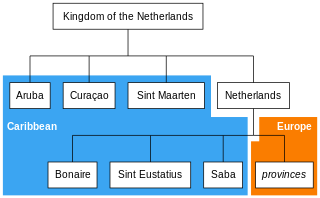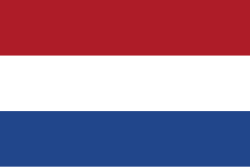Top Qs
Timeline
Chat
Perspective
Dutch Caribbean
Caribbean territories of the Kingdom of the Netherlands From Wikipedia, the free encyclopedia
Remove ads
The Dutch Caribbean[a] (historically known as the Dutch West Indies) are the New World territories, colonies, and countries (former and current) of the Dutch Empire and the Kingdom of the Netherlands located in the Caribbean Sea, mainly the northern and southwestern regions of the Lesser Antilles archipelago.
The Dutch Caribbean comprises the constituent countries of Curaçao, Aruba and Sint Maarten (the 'CAS' islands) and the special municipalities of Bonaire, Sint Eustatius and Saba (BES islands).[1] The term "Dutch Caribbean" is sometimes also used for the Caribbean Netherlands, an entity consisting of the three special municipalities forming part of the constituent country of the Netherlands since 2010.[3][4] The population of the Dutch Caribbean is 337,617 as of January 2019.[1]
Remove ads
History
Summarize
Perspective

The islands of the Dutch Caribbean were, formerly, part of Curaçao and Dependencies (1815–1828), or Sint Eustatius and Dependencies (1815–1828), which were merged with the colony of Suriname (not actually considered part of the "Dutch Caribbean", although it is located on the Caribbean coast of northeastern South America). They were governed from Paramaribo, Suriname, until 1845, when all the islands again became part of Curaçao and Dependencies.
In 1954, the islands became the land (Dutch for "country") of Netherlands Antilles, lasting until 2010. The autonomy of the Netherlands Antilles' island territories was stipulated in the Islands Regulation of the Netherlands Antilles. Initially, the Netherlands Antilles consisted of four island territories—Aruba, Bonaire, Curaçao and the SSS islands. The latter split into the Island Territories of Saba, Sint Eustatius and Sint Maarten, in 1983.
The island of Aruba seceded from the Netherlands Antilles in 1986 to become a separate constituent country of the Kingdom of the Netherlands, leaving five island territories within the Netherlands Antilles. This arrangement lasted until the complete dissolution of the Netherlands Antilles, as a unified political entity, in 2010; that year, Curaçao and Sint Maarten became autonomous constituent countries within the Kingdom (like Aruba). Bonaire, Sint Eustatius and Saba became special municipalities of the Netherlands proper (located on the European mainland), a member state of the European Union.
Remove ads
Geography
Summarize
Perspective


Geographically, the six entities of the Dutch Caribbean are clustered into two vastly separated areas of the Caribbean:
- Three are at the far northern end of the Leeward Islands, thus, the far northern end of the Lesser Antilles. From north to south, these are Sint Maarten (occupying roughly the southern half of the island of Saint Martin), Saba, and Sint Eustatius.
- From west to east, Aruba, Curaçao and Bonaire are located just off of the Caribbean coastline of northern Venezuela, at the far western end of the Leeward Antilles (which extend west from the southern end of the Windward Islands—thus they are at the southwestern end of the Lesser Antilles).
Politically, each (six) entity of the Dutch Caribbean currently has one of two relationships with the Netherlands:
- Three have the status of being constituent countries of the Kingdom of the Netherlands.
- Three have the status of being special municipalities of the Netherlands alone, as distinct from the Kingdom in its entirety.
Constituent countries
Three Caribbean polities are landen (Dutch for "countries") within the Kingdom of the Netherlands: Aruba, Curaçao, and Sint Maarten. The Netherlands is the fourth and largest constituent country in the Kingdom.
Sint Maarten comprises the southern half of the island of Saint Martin. The northern half of the island (the Collectivity of Saint Martin) is an overseas territory of France. Aruba and Curaçao are located in the far south of the Caribbean, roughly 30 kilometres and 65 kilometres from the coast of Venezuela, respectively.
Special municipalities

The three Caribbean islands that are special municipalities of the Netherlands alone are Bonaire, Sint Eustatius, and Saba. Abbreviated collectively, these are also known as the "BES islands", or the Caribbean Netherlands. Bonaire is located in the far south of the Caribbean, being about 80 kilometres north of the coast of Venezuela; Saba is located about 50 kilometres south of Sint Maarten, and boasts the highest mountain in the Netherlands, Mount Scenery, at 880 m (2,887') above sea level). Sint Eustatius is located directly north of Saint Kitts.
Remove ads
Dutch Caribbean islands
Photo gallery
- Oranjestad, Aruba
- Bonaire
- Curacao
- Saba
- Sint Eustatius
- Sint Maarten
Grouping of islands
The islands have also been informally grouped in the following ways.
- Geographically, by location in the Lesser Antilles (in alphabetical order):
- ABC islands, for Aruba, Bonaire, and Curaçao (within the Leeward Antilles group)
- SSS islands, for Saba, Sint Eustatius, and Sint Maarten (within the Leeward Islands group)
- Politically, by constitutional status (in order of population size):
- CAS islands, for Curaçao, Aruba, and Sint Maarten (constituent countries of the Kingdom of the Netherlands)
- BES islands, for Bonaire, Sint Eustatius, and Saba (special municipalities of the Netherlands)
Remove ads
Demographics
Summarize
Perspective
Ethnic groups
The populations of the Dutch Caribbean descend from a diverse array of ethnic groups from Europe, Africa, South-America and Asia.[5] Aruba has more European and Amerindian ancestry on average,[6] while the other islands such as Curaçao have more African ancestry on average.[7]
The islands' populations have grown significantly in recent decades with a large percentage being foreign-born, mostly due to immigration to the islands from various countries and territories.[8]
Languages
Inhabitants of the Dutch Caribbean are multilingual, speaking 2 to 4 (or more) languages at varying although often high degrees of fluency.[9]
Papiamento, a Portuguese-based creole with influences from Spanish, Dutch, West-African and Amerindian languages,[10] is official and the predominant language on Aruba, Bonaire and Curaçao.[11] There are 2 main dialects of the language, Papiamento (Aruba) and Papiamentu (Curaçao and Bonaire). There are also small minorities of Papiamento speakers on the SSS Islands.[12]
English is official and predominates on Sint Maarten, Saba and Sint Eustatius. Local varieties of Virgin Islands English Creole are also spoken.[13] English is also widely known and spoken on Aruba, Bonaire and Curaçao (especially on Aruba).
Spanish is widely known and spoken on Aruba, Bonaire and Curaçao due to proximity, historical and cultural connections to Venezuela and Colombia. Many Spanish-speaking immigrants from Latin-America also reside on the Dutch Caribbean islands, especially on the ABC Islands.
Dutch is an official language on all 6 Dutch Caribbean islands, however it is not the native or common language on any of the islands,[14] although most inhabitants do know and can speak Dutch to varying degrees. Dutch is primarily used in official, legal matters, jobs and in education on the islands.
Other languages such as Portuguese, Haitian Creole, French, Italian, Sranan Tongo, German, Chinese, Tagalog, Hindi are also spoken by smaller communities of speakers on the islands.
Remove ads
See also
Notes
- Dutch: Caribisch deel van het Koninkrijk der Nederlanden, lit. 'Caribbean part of the Kingdom of the Netherlands'; colloquially de CAS- en BES-eilanden, 'the CAS and BES islands'.
References
External links
Wikiwand - on
Seamless Wikipedia browsing. On steroids.
Remove ads








